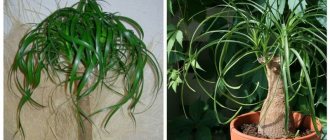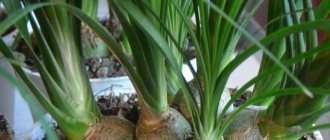Blooms in late spring - summer. Spike-shaped inflorescences consisting of numerous stamens appear at the tops of young shoots. In appearance, the flowers resemble brushes used to wash dishes. Thanks to the bright fluffy inflorescences, the tree looks elegant. Under natural conditions, the plant is found in New Caledonia, Tasmania, and the homeland of callistemon is Australia.
Also look at the wonderful myrtle plant from the same family.
| average growth rate. |
| Blooms from mid-spring to late summer. |
| Average ease of growing. |
| Perennial. |
Useful properties of callistemon
Callistemon leaves contain essential oils. A pleasant smell can be felt by rubbing them with your fingers or accidentally damaging a leaf. Essential oils, when evaporated, enrich the air with phytoncides, thereby reducing the risk of a cold. The aroma of callistemon calms the nervous system and improves mood. The healthy cuttings remaining after pruning are used in a home beauty salon: they are used to prepare decoctions and tinctures that improve the condition of problem skin.
Features of care
Caring for callistemon is not difficult. This culture is considered very unpretentious. However, the flower requires the creation of special conditions. It needs bright lighting. The leaves of the plant should be exposed to direct sunlight for several hours a day.
When growing a crop in a hot room, it should be shaded from the bright midday sun or moved to fresh air. In the winter season, the flower needs artificial lighting. In its absence, there is a risk of problems during the formation of flower buds.
Red stamen requires regular soil moisture. Like all tropical plants, the crop does not respond well to severe dry soil. At the same time, the shoots lag behind in growth and become bare. Liquid stagnation is also unacceptable. It provokes rotting of the root system. For irrigation, you should use purified water. It should be at room temperature.
Callistemon leaves are covered with a thin waxy coating. Moisture from their surface evaporates weakly. Therefore, there is no need to artificially increase air humidity. In this case, the crop can be periodically sprayed and bathed. Manipulations should be performed before or after flowering.
From April to September, the crop needs systematic application of mineral fertilizers. It is recommended to use formulations for flowering crops. They should be mixed with water and applied to the soil 2 times a month.
As the bush develops, many side shoots appear. To get a beautiful crown, it is worth systematically pruning it. This helps ensure more abundant flowering next year. It is necessary to prune the bush when it reaches 50-60 cm. It is best to do this at the end of summer after flowering has ended.
Callistemon: home care. Briefly
In order for callistemon to grow into a beautiful tree at home, you need to try and create optimal conditions:
| Temperature | in summer – no higher than + 22°C, in winter – 10 – 12°C. |
| Care according to the seasons | in winter, the young tree is kept in good light; in summer they take it outside; after a year, they are planted in the garden for the warm season, moved home in winter and arranged for a cool winter; callistemon will bloom in summer |
| Air humidity | moderate; in the summer they spray it every other day and give it a shower |
| Lighting | bright; placed on the south, southwest or southeast windows. |
| Watering | in winter - once every 12 days, in summer - once every 8 days; good drainage is needed. |
| Soil for callistemon | universal soil for flowers or a soil mixture of equal parts of humus, leaf soil, sand and turf soil. |
| Feeding and fertilizer | once every 2 weeks - with universal mineral fertilizer, diluted several times; sometimes with diluted organic fertilizer. |
| Callistemon transplant | young plants - every year, in spring; adults - every 3 years. |
| Reproduction | using seeds and cuttings. |
| Features of cultivation | With the onset of warm weather, the bush is taken out onto the balcony or into the garden: an influx of fresh air is necessary for the growing season. After each flowering, callistemon shoots are pruned to stimulate branching of the plant and lay the foundations for new flowering. |
Choosing a site for planting and preparing the soil
To plant callistemon, it is recommended to choose the eastern, western or southern side. The main thing is that there is a lot of diffused light in this place.
Although the culture has an exotic origin, it does not tolerate hot weather well. In the summer, the optimal temperature is +20-22 degrees. In winter it should be +12-16 degrees.
It is recommended to plant the crop in a nutrient substrate. To prepare it, you need to mix turf soil, deciduous soil, peat and river sand in a ratio of 4:2:2:1.
Landing dates
It is allowed to plant indoor flowers in the ground from August to March.
Caring for callistemon at home. Details
Even a novice gardener can successfully grow a beautiful flowering callistemon bush at home if he truly loves plants and tries to create optimal conditions for his green pet.
Callistemon flowering
At the end of spring, callistemon begins to bloom.
The spectacle impresses with its originality and beauty. The unusualness of the flowering plant lies not in the elegance, delicacy or color of the petals (they are generally hard to see), but in the large number of bright stamens with a golden dot at the end. Red, crimson, cream, orange and even green stamens on the tops of young shoots are collected in fluffy spike-shaped inflorescences. Their length often reaches 13 cm, and their width ranges from 5 to 10 cm. After flowering is completed, the stamens are replaced by round fruits that cling tightly to the shoots. At home, callistemon does not form seeds, because birds do not pollinate it here.
Temperature
In order for the callistemon plant to develop correctly and bloom beautifully at home, it is necessary to observe the temperature regime. To do this, keep the tree cool in winter, without raising the temperature above + 12°C. In summer, callistemon develops well at + 20 – 22°C and frequent ventilation.
The plant should be protected from drafts and not placed near an air conditioner.
Spraying
Homemade callistemon has a reserved attitude towards dry air and prefers moderate humidity from 35 – 60%. In the summer, the tree is sprayed several times a week and given a warm shower. The procedure will also protect the plant from pests. Open containers with water are placed next to the pot. This is especially important during the heating season.
Lighting
The callistemon tree is sensitive to light; for normal growth it needs not just good, but bright lighting. It should be borne in mind that excess light can cause leaf burns, and its lack will negatively affect flowering.
Therefore, caring for callistemon at home recommends placing the plant in the southern, southwestern or southeastern parts of the room. If you place a pot with a tree on a window facing south, it must be shaded from the bright sun at noon. If there is not enough light, turn on the phytolamps.
Watering callistemon
Callistemon is a moisture-loving plant.
When caring for it, it is important to ensure that the soil does not dry out. In summer, callistemon is watered every 8 days, in winter - every 10 days. Water with well-settled lukewarm water. If the water contains a lot of chlorine, it is softened by adding 0.2 g of citric acid or 2 - 3 drops of lemon juice per liter of water. It is useful to water callistemon with this water up to three times a month. Do not allow moisture to stagnate in the soil. Stagnation leads to rotting of the root system. To prevent the death of the plant, create a good drainage layer, and add raising agents (vermiculite, perlite, agrovermiculite) to the soil.
Callistemon pot
The development of the plant depends on the correctly selected pot. A pot for callistemon needs to be moderately deep so that its root system and drainage layer can fit there. In this case, the container should be a little cramped. This is necessary for beautiful callistemon flowering.
If the pot you purchased does not have drainage holes, you will need to make them yourself.
Priming
The tree can be planted using a universal flower substrate that has a slightly acidic reaction. You can also prepare soil for callistemon with your own hands, taking leaf soil, humus, sand, and turf soil in equal parts. To improve the quality of the substrate and enhance drainage properties, chopped sphagnum, brick chips, vermiculite, and coconut substrate are added to it.
Feeding and fertilizer
To ensure beautiful flowering and keep the plant in good shape, fertilizing and fertilizer are used. From the beginning of March until mid-autumn, use a universal remedy for flowering plants, diluted in half. It is necessary to pay attention that the fertilizing contains a minimum amount of calcium: it has a bad effect on the tree.
Sometimes organic matter is used in highly diluted form. Feed callistemon once every 14 days, after evening watering. After feeding, the plant is shaded for a day. In winter, all fertilizers are canceled. After transplantation, 2 weeks should pass, then feeding is resumed, otherwise the tree can easily be overfed.
Transfer
Young trees are replanted every spring. Callistemon grows intensively, quickly developing a root system. Mature callistemon is transplanted when its roots completely engulf the earthen ball - approximately every three years.
For completely mature plants, the top layer of soil is renewed. When replanting, the pot is replaced with a container of larger diameter.
How to trim callistemon
To ensure that the callistemon crown looks perfect, thin and damaged shoots are pruned every year after flowering. Pruning promotes good branching and beautiful flowering of the plant. Young specimens are pinched so that they do not stretch to gigantic sizes.
Callistemon bonsai
Original bonsai-style compositions made from callistemon perfectly enliven the interior. To create a unique tree, use wire and small weights. Using these materials, callistemon shoots are bent in the desired direction and secured with weights.
When the branches become woody, the devices are removed. The shoots are shortened to the desired length. This neat mini-tree will delight you with its unusual shape.
Rest period
From mid-October, callistemon begin to prepare for wintering. Reduce watering and gradually lower the temperature. The resting period of callistemon falls in November - February. At this time, the plant is not fed; Water rarely, but make sure that the soil does not dry out or become crusty. There is no need to reduce the lighting intensity, otherwise the callistemon will bloom poorly.
If there is not enough light at home, turn on additional lighting.
Botanical characteristics
Callistemon is a genus of evergreen shrubs and trees. In nature, their height is 0.5-15 m. Domestic specimens are more modest in size. The shoots branch from the base and form a dense but rather uneven crown. The lateral processes protrude in all directions. They are covered with short petiolate leaves with a leathery surface and slight pubescence on the back. Lanceolate leaf plates with a pointed edge are attached to the shoots alternately; a relief central vein is clearly visible on them. The surface of the foliage contains small glands that secrete essential oils.
In May-July, spike-shaped inflorescences bloom at the ends of the shoots. Like most myrtaceae, the flowers have no petals, but contain numerous bunches of long stamens. Most often they are colored red, but there are varieties with orange, yellow and white inflorescences. The length of the inflorescence, similar to a brush, is 5-12 cm, and the width is 3-6 cm.
Callistemon is pollinated by small birds. After this, at the beginning of autumn, the fruits ripen - spherical seed pods. They are covered with a dense woody shell. The capsule, 5-7 cm in diameter, contains small brown seeds.
Callistemon reproduction
Callistemon is propagated at home in two ways.
Growing callistemon from seeds
Held in the first half of February. The seeds are soaked in potassium permanganate, then laid out on a moistened substrate and covered with glass or film. The container with the crops is kept in a warm room at + 23° C. The cover is removed for watering and ventilation. When shoots appear, the shelter is removed. Young seedlings that have grown to 7 cm are planted in separate pots.
Callistemon propagation by cuttings
Carry out after pruning the plant. Cut off strong cuttings are treated with a root formation stimulator and planted in moist soil. A sign of successful rooting will be the appearance of young leaves. Then the cuttings are transplanted into separate containers.
Propagation by cuttings is the most affordable and fastest way to grow callistemon at home. A tree obtained in this way will bloom earlier.
Diseases and pests
If not properly cared for, callistemon can sometimes be affected by diseases and pests. The appearance of the plant will immediately tell you about the troubles:
- callistemon leaves dry and fall off - excess moisture, lack of lighting (change the substrate, adjust watering and move to a brighter place);
- callistemon dries out - substrate with an alkaline reaction (use fertilizers that do not contain calcium; transplant into slightly acidic soil);
- grows slowly and blooms poorly - poor lighting (move to a brighter place);
- leaves fall off - excess moisture or placement in a draft (transplant into another soil, adjust watering; protect from drafts);
- yellow and brown spots on callistemon leaves – sunburn (in hot weather, cover from bright direct rays of the sun; spray in the shade or in the evenings).
Callistemon is resistant to attack by pests, but sometimes it is affected by scale insects, spider mites, and mealybugs. Insecticides are used against insects.
Care according to the seasons
In winter, a young exotic will be comfortable in the brightest place, and in the summer months it can be taken out into the yard under cover. A year later, in the spring, the bush can be pampered by planting it outside, and by autumn it will already be a lush callistemon tree with a densely leafy crown. In the fall, it should be replanted in a pot and wintered in a bright, cold corridor at a temperature of 7-10 ° C. The tree can winter almost without watering. In the summer, in the fourth year of life, callistemon will reward your efforts and delight you with its first flowering.
It should be taken into account that with good care, this special tree can grow not only high, almost up to two meters, but also wide. There won't be enough space for him in the apartment. Then such a colossus can be installed, for example, in a school. The conclusion follows from this: callistemon requires obligatory pinching, and when the height of the plant reaches 20-30 centimeters. To prevent the exotic from overgrowing, the branches should be shortened every spring, thereby forming a compact tree or bush.
Types of callistemon domestica with photos and names
There are different types of callistemon that take root well at home.
Lemon Callistemon (Callistemon citrinus)
A short tree with a dense crown and scarlet inflorescences, the length of which reaches 0.1 m. Green leaves emit a pleasant lemon scent. A popular species with many varieties.
Callistemon viminalis
A low shrub with drooping shoots and bright orange or red inflorescences.
Callistemon salignus
A tall, well-branched shrub with whitish thin shoots and cream or bright white inflorescences with many golden stamens. Reminds me of a blooming willow tree.
Callistemon rigidus
A tall tree with erect, upward-pointing shoots and fluffy crimson inflorescences.
Callistemon bright red (Callistemon coccineus)
Tall (up to 4 m) shrub with gray-brown shoots and inflorescences of pink-red shades.
Pine Callistemon (Callistemon pityoides)
A tree up to 3 m high. The leaf blades are short and thin, similar to the needles of coniferous plants. The bark of young trees is gray with a silver tint; in adult plants it turns into dark emerald. The inflorescences are cream with a greenish tint.
Bright fluffy callistemon inflorescences bring comfort and joy to the home. The exotic's original appearance, combined with its absolute pickiness, explains its growing popularity.











